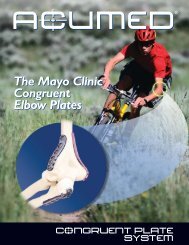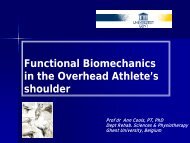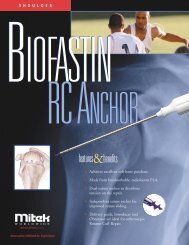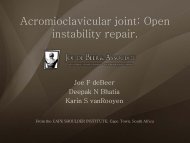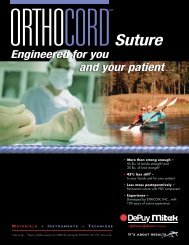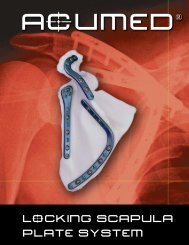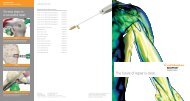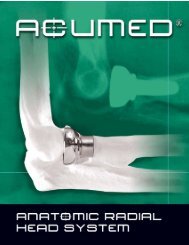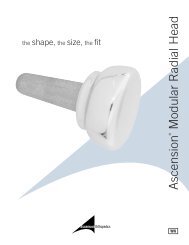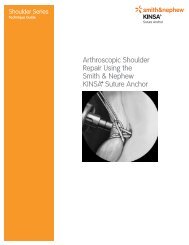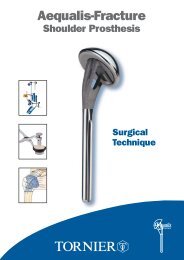Delta and Bone deficiencies - ShoulderDoc.co.uk
Delta and Bone deficiencies - ShoulderDoc.co.uk
Delta and Bone deficiencies - ShoulderDoc.co.uk
- No tags were found...
Create successful ePaper yourself
Turn your PDF publications into a flip-book with our unique Google optimized e-Paper software.
Werner et al. JBJS 2005 <strong>Delta</strong> reverse 50 patients (50/58)• 17 cuff tear arthropathy• 41 revision of failedarthroplasties 15 men 43 women Mean age 68 (44-84) Mean follow up 38months (minimum 24)
Results Werner et alprimarypreop postop Constant s<strong>co</strong>re 35 72(relative) Active forw flex 43 103 Pain (VAS) 5,9 1,8Only patients with active FF < 90degrees
Complications Werner etal. Infection3/17 Hematoma 3/17 Dislocation 1/17 Disloc PE insert 1/17 Fx acr/spine 1/17 No loosening Total 9/17
Radiographs 48 pts avaiable for radiographic followup 46 % of patients had notching grade 3-4(Nerot) Notching did not affect clinical out<strong>co</strong>me
Walsh series, JBJS 2007240 reverse arthroplasty, 31% wasCTA patients
Walsh series- Notching 152/186 with 2 years follow up hadadequate X-rays 51% had notching Constant s<strong>co</strong>re 61 in pts w notching Constant s<strong>co</strong>re 59 in pts withoutnotching
St Göran´s Hospital Follow up Female 43Male 1962 (17 primary) Mean age 74 (range 42-94) Minimum follow up Independent observer2 years Only pseudopartalytic shoulders
Ekelund CTA primary Constant 16 53 p
Complications Ekelund 2 infections No asepticloosening
Revision arthroplasty Flexion 23 86 p
Sirveaux et al. JBJS 2004 <strong>Delta</strong> reverse 80 shoulders (77pts) (80/92) 14 men, 63 women Mean age 73 (60-86) Follow up mean44,5 months (24-97
Results Sirveaux et al. Constant s<strong>co</strong>rePreopPostop23 (4-50) 66 (34-85) P
Complications Sirveaux etal. 4 revisions (1 infection, 3loosening/unscrewing) Glenoid loosening 6%(5/80) Humeral loosening 1%(1/80) Scapula notch 50%(grade 3-4 in 16%)• Grade 3-4 affectedConstant s<strong>co</strong>re(p
Survivorship Sirveaux et al. If failure = revisionsurgery, theprobability of nothaving a revision at 8years was 95% If failure = revision,unscrewing,loosening orsignificant pain; thesurvivorship was 29%at 8 years
Specific problems Restoration of external rotation• <strong>co</strong>mbine with latissimus dorsi/ teresmajor transfer Scapula notching• Excessive polyethylene wear• Osteolysis• Clinical significance unclear• Surgical technique <strong>and</strong> implant design
Anatomy If IS <strong>and</strong> Teres minor are missing oratrophic worse clinical results(Constant s<strong>co</strong>re)French multicenter studyTeres minor IntactCS68Teres minor affected CS 61Boileau et al. 2005Teres minor ok CS 66Teres minor torn CS 46Gerber et al 2007Teres minor OK CS 83%Teres minor atrophic CS 61%
My technique lat dorsitransfer Through the Deltopectoralincision• Release only sup 1,5-2cm of pec major• Release if possible onlylat dorsi, sometimesalso teres major• Pull it around humerus• Reattach more suptowards the area forteres minor insertion,(osteosutures)• Orthosis 4 weeks
Indications Lack of strength in external rotationin 0 abduction <strong>and</strong> 90 degrees ofabduction• Pos ”hornblower´s sign” ”Younger” patient population amongthe reverse group og patients
Reported <strong>co</strong>mplicationsInfectionDislocationScapula notchingLooseningGlenoid unscrewing (olddesign)Humerus unscrewing(humerus defect)Fx tip of the implantHematomaDislocation insertFracture of the spine ofscapula
<strong>Delta</strong> 1995-2002 118 <strong>Delta</strong>s, 79 women, 34 male 45 were revisions of failed anatomicalimplants 26 pts have undergone reoperations ( 22%)• Revisions cases (27%), primary <strong>Delta</strong> (19%) Infections 7,6% (9/118) Dislocations 7,6% (9/118), 8 in revision cases 12 pts (10%) had 2 or more reoperationsafter <strong>Delta</strong> implantation
<strong>Delta</strong> Xtend 2006- Over 100 cases No infections 2 dislocations both in revisions 1 humeral loosening in a crutchdependent obese patient with proxboneloss
ComplicationsTry save the <strong>Delta</strong>arthroplasty if• dislocation• infection• looseningResection arthroplastyrareConvert it to ahemiarthroplasty byreplacing insert withhead, bone graftglenoid.
”I love the <strong>Delta</strong>…” Preop:• 85 years old lady• Severe pain 5 years• Pseudoparalysis• Cuffteararthropathy• Depression Postop <strong>Delta</strong>• No pain• No limitation offunction
Summary reversed arthroplastyCan restore function inpseudoparalytic shouldersExcellent pain reliefCannot restore external rotation• Lat dorsi/TM transferScapula notching a <strong>co</strong>ncern• Need more longterm follow upto evaluate clinical significance• Low metaglene positioningRate of <strong>co</strong>mplications significantlyreduced with new design <strong>and</strong>improved technique
Thank You!



